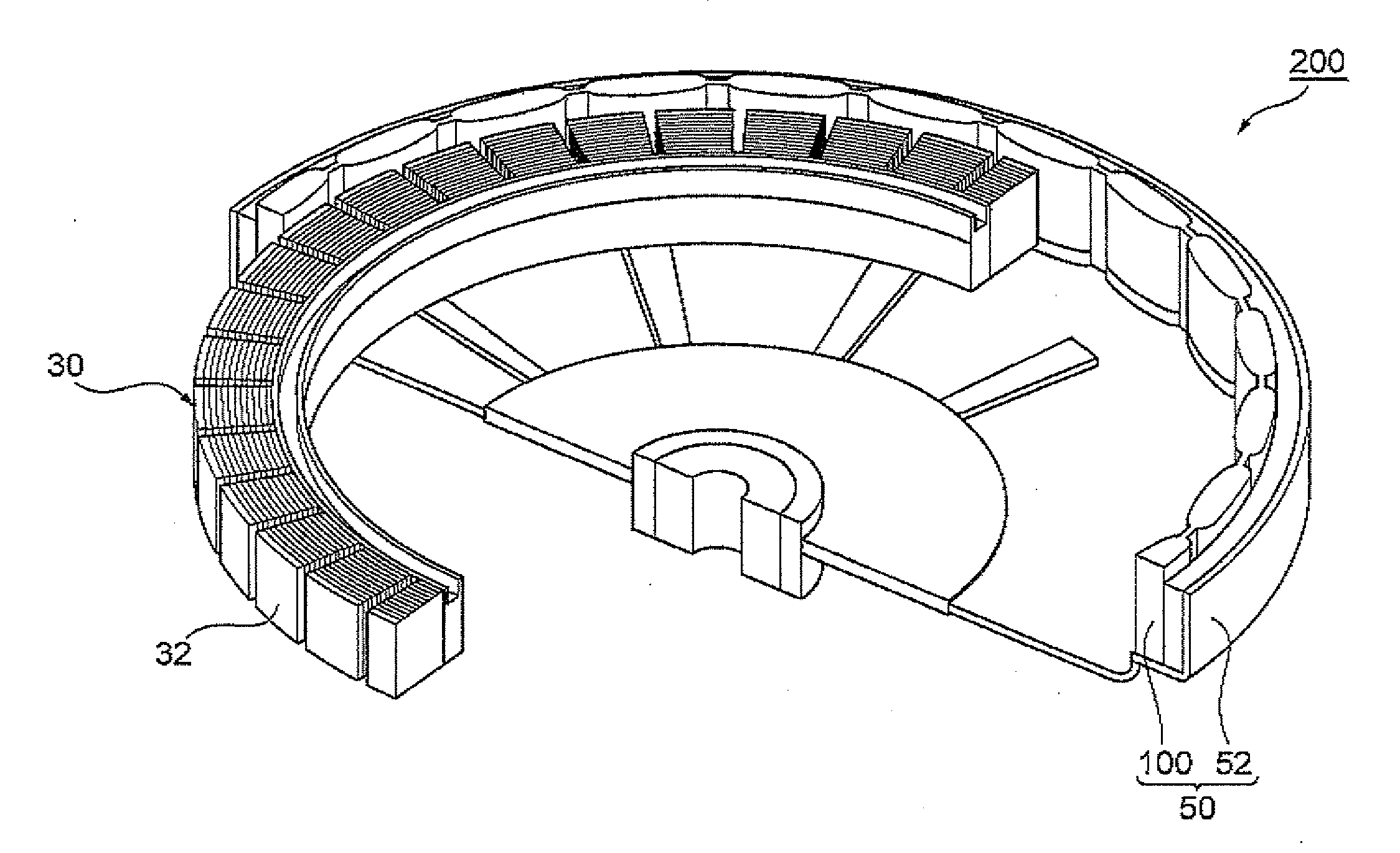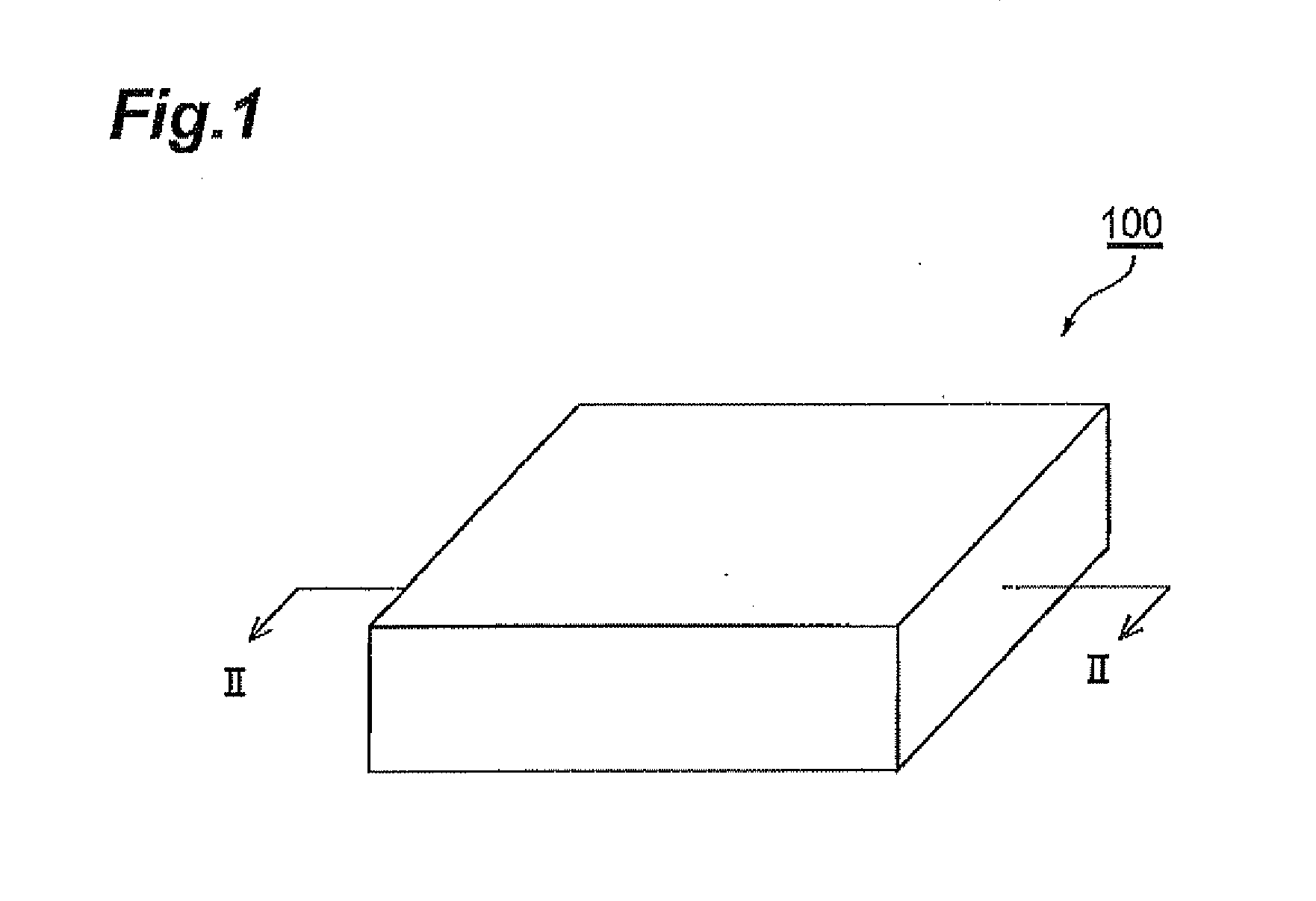Rare-earth sintered magnet, rotator, and reciprocating motor
a technology of rotor and magnet, which is applied in the direction of magnets, magnetic materials, magnetic bodies, etc., can solve the problems of easy corrosion of rare earth sintered magnets, and achieve the effects of excellent magnetic characteristics, excellent performance, and high corrosion resistan
- Summary
- Abstract
- Description
- Claims
- Application Information
AI Technical Summary
Benefits of technology
Problems solved by technology
Method used
Image
Examples
example 1
Making of a Magnet Body
[0067]An ingot made of an Nd—Dy—Fe—B-based alloy was obtained by a powder-metallurgical method. This ingot had a composition comprising 27.4 mass % of Nd, 3 mass % of Dy, 68.6 mass % of Fe, and 1 mass % of B. The ingot was pulverized by a stamp mill and a ball mill, so as to yield a fine alloy powder having the above-mentioned composition.
[0068]Thus obtained fine alloy powder was press-molded in a magnetic field, so as to prepare a molded body. The molded body was sintered while being held at a temperature of 1100° C. for 1 hr, so as to yield a sintered body. Thereafter, an argon gas at normal temperature was introduced, so as to cool the sintered body rapidly to normal temperature. After the cooling, the sintered body was processed into a rectangular parallelepiped form having a size of 20×20×12 (mm), whereby a magnet body was obtained.
[0069]Preprocessing
[0070]The magnet body was subjected to preprocessing which sequentially carries out alkaline degreasing, w...
example 2
[0082]A rare-earth sintered magnet was produced as in Example 1 except that a salt-bath heat treatment agent having the following composition was used for salt-bath processing and that the temperature of the molten salt was 580° C. The rare-earth sintered magnet of Example 2 was thus obtained.
[0083]Sodium cyanide (NaCN): 35 mass %
[0084]Potassium cyanate (KCNO): 55 mass %
[0085]Potassium carbonate (K2CO3): 10 mass %
[0086]Thus obtained rare-earth sintered magnet was analyzed as in Example 1. As a result of the X-ray diffractometry, the surface part of the rare-earth sintered magnet was mainly composed of nitrides of iron (ε-Fe2-3N and γ-Fe4N). As a result of the glow discharge optical emission spectrometry, the nitrogen content was 3 mass % or more in the region extending by a depth of 3 μm from the surface of the rare-earth sintered magnet. When the depth from the surface exceeded 3 μm, on the other hand, the nitrogen content decreased greatly as the depth increased. In the region whe...
example 3
[0087]An ingot made of an Nd—Dy—Fe—Co—B-based alloy was obtained by a powder-metallurgical method. This ingot had a composition comprising 27.4 mass % of Nd, 3 mass % of Dy, 61.4 mass % of Fe, 7.2 mass % of Co, and 1 mass % of B. The ingot was pulverized by a stamp mill and a ball mill, so as to yield a fine alloy powder having the above-mentioned composition. A rare-earth sintered magnet was produced as in Example 1 except that the above-mentioned fine alloy powder was used in place of the fine alloy powder of Example 1. The rare-earth sintered magnet of Example 3 was thus obtained.
[0088]Thus obtained rare-earth sintered magnet was analyzed as in Example 1. As a result of the X-ray diffractometry, the surface part of the rare-earth sintered magnet was mainly composed of a nitride of iron (ε-Fe2-3N) and a nitride of cobalt (CO3N). As a result of the glow discharge optical emission spectrometry, the nitrogen content was 5 mass % or more in the region extending by a depth of 5 μm from...
PUM
| Property | Measurement | Unit |
|---|---|---|
| Percent by mass | aaaaa | aaaaa |
| Length | aaaaa | aaaaa |
Abstract
Description
Claims
Application Information
 Login to View More
Login to View More - R&D
- Intellectual Property
- Life Sciences
- Materials
- Tech Scout
- Unparalleled Data Quality
- Higher Quality Content
- 60% Fewer Hallucinations
Browse by: Latest US Patents, China's latest patents, Technical Efficacy Thesaurus, Application Domain, Technology Topic, Popular Technical Reports.
© 2025 PatSnap. All rights reserved.Legal|Privacy policy|Modern Slavery Act Transparency Statement|Sitemap|About US| Contact US: help@patsnap.com



